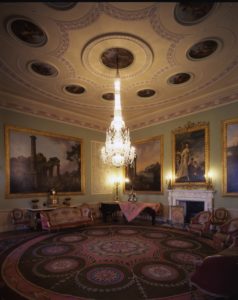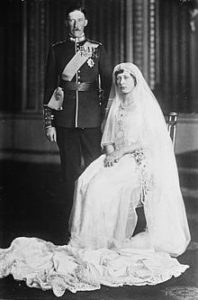The study of the Irish country house has attracted a great deal of attention from scholars in recent years who have begun to unravel many aspects of its history, in particular its relationship with the wider Irish society. The architecture and material culture of the country house have also attracted a plethora of recent publications. However, there are many aspects yet to be researched. One of these is the electrification of the country house, part of the modernisation processes of the early twentieth century. This study was carried out with the guidance of Professor Terence Dooley of the Centre for the study of Historical Irish Houses and Estates (CSHIHE) at Maynooth University, for an undergraduate module on the Irish country house. The electrification of the Irish country house project was based on research using estate records in the National Library of Ireland. These included the electrical specifications and reports on two country houses, namely Doneraile Court in County Cork and Westport House in County Mayo. Below is the original copy for the electrical specifications for Doneraile Court (note the date 1906). The project appealed particularly to me as I am a qualified electrician.
By 1910, the electrification of Irish country houses was spreading. But why did country house owners, who had previously spent enormous amounts of money installing gas lighting, then decide to install this new technology? There were four main reasons. Firstly, electricity was adopted within Irish country houses because of its practical advantage over gas. Although gas lighting did provide the house with adequate illumination, it also produced unpleasant and damaging fumes which were deemed potentially harmful to the residents and interior fabric . Secondly, despite declining finances, the late nineteenth century was an era of conspicuous consumption and many country house owners “had a demand for the latest thing.” [1] Many new clients of electricity in the domestic sphere were considered ‘progressives’, politically, socially and aesthetically, and the demand for electricity was driven by fashion and a desire for modernity. Thirdly, certain houses received capital injections of income from the sale of land under Government land acts, during the early twentieth century in Ireland, in particular the 1903 Wyndham Land Act. Finally, during an era when night-time normally brought darkness to the whole countryside, an illuminated house was possibly seen as another potent status symbol.

Figure 1: Specification and Estimate for Doneraile Court.
Source: Electrical installation specification, in Doneraile papers MS 34, 107/11, National Library of Ireland, Dublin, Ireland, 22 October 1906.
Permanent private electrical lighting installations required a self-sufficient, electrical generating system including a dynamo, driven by a power source such as a waterwheel or a water-powered turbine, steam engine or internal combustion engine. In 1906, Lord Castletown (Bernard Edward Barnaby FitzPatrick, 2nd Baron Castletown 1849-1937) of Doneraile Court in County Cork was eager to modernise his house. [2] The man in charge of this installation was T. W. Storey, chief engineer and manager of the Alliance Electrical Company Limited, Dublin. Lighting a mansion such as Doneraile Court in 1908 required 383 diverse light fittings and the whole installation cost £1098 11s 11d (£83,000 today). The “Specification & Estimate” for Doneraile Court provides a valuable insight into the electrification of large houses in the early twentieth century. Since Doneraile Court contained its own sawmill, it was proposed to drive the dynamo designated for the house via belting. This was done from a counter shaft in the engine house, thus saving the expense of a separate engine. The dynamo machine used was a “Standard I.G type dynamo” and cost £74 2s. 6d. [3]
In Doneraile Court, the supply of electricity to the house meant a 500 yard overhead run of cables (via wooden poles) from the main switchboard beside the dynamo in the engine house to the main house. In order to maintain the authenticity of the landscape, these wooden poles were hidden by meandering them strategically through the woodland. The type of cable used for this long run was: “stranded copper 7/16 insulated with triplex aerial insulation on high tension insulation”. [4] This type of cable was necessary as it provided suitable protection from the trees within the grounds. If the trees came into contact with electrical conductors (cables) that had poor insulation, it would cause a short circuit, thus creating a major electrical fault.
Similarly, Westport House in County Mayo underwent huge remodelling and modernisation in the early twentieth century. This can be largely attributed to the 6th Marquess of Sligo (George Ulick Browne 1856–1935), who was the newly established owner, after his father passed away. [5] The 6th Marquess obtained a wide knowledge of the workings of the estate and in doing so, made essential improvements to the house with regard to plumbing, heating and electricity around 1914. The Marques hired R. E. Mellon, an architect, A. E. Porte, a consulting engineer and T. E. Brunker, an electrical engineer, to oversee the entire operation. Overall, 250 light fixtures were installed and the whole installation cost £800 (£67,000 today). [6]
The control centre for the installations in Doneraile Court and Westport House were the main switchboards. In the days before the use of plastic materials and miniaturisation of components, this was a very impressive piece of equipment. Below is an example of an early twentieth century switchboard and it illustrates the various parts of a typical lighting switchboard used during this period. There are two circuits. The components on the left hand side are for charging and those on the right hand side for discharging. Furthermore, each circuit is protected with fuses and an ammeter to monitor the respective currents. The switchboard cost £49 and had to be fitted as near to the dynamo as possible.

Figure 2: Lighting Switchboard.
Source: Charles Carson, Technology and the Big House in Ireland, c.1800-c.1930 (New York, 2009).
Once electricity had reached the house, the next phase of the operation was wiring the house with lights, switches and fixtures. In Doneraile Court, the type of cable that was used throughout the house was referred to as “B” type. [7] This type of cable was insulated with PVC and had a guaranteed resistance of 1250 mega ohms. In both houses the methods used to contain wires within the houses was similar. As they were eighteenth century houses T. E. Brunker asserted that ‘cutting out and making good’ would be necessary, that is cutting through walls, partitions, ceilings, floors and so on. However, there were methods used to limit the damage to the house whilst wiring for electricity. In Westport House, a lot of the cables were wired under the floorboards, out of sight, as much as possible. This involved the lifting of floor boards throughout the house and pulling the cables through the main structural joists to their designated location.
A supplementary method called wooden casing/capping (illustrated below) was employed in both houses, to hide wires. In the Doneraile Court specifications, the electrical contractor expected “all cables and wires would be enclosed, hidden out of sight in American wooden casing.” [8] The carpenter and the electrician had to work together, and it was the electrician who decided what pieces of wood needed modification. I examined a rewiring project by the National Trust in England. The house in question was Cragside in Northumberland, which in 1880 was one of the first houses to be wired electrically. Much of the capping and casing used in this example was under the floorboards, inside the walls, around door frames, within skirting boards, all designed to avoid altering the house’s appearance.

Figure 3: Example of Timber casing and capping
Source: Electrical topics, ‘Wooden casing and capping wiring’ available at: (http://electricaltopics.blogspot.ie/2015/04/wooden-casing-and-capping-wiring.html).
When the house was wired, switches were required, either to break an electrical circuit (turning off a light) or to divert current from one conductor to another. In Doneraile Court and Westport House, the type of switches that were used were of a Tumbler pattern, having porcelain base and polished brass cover. The diagram below demonstrates the inner working of the switch.

Figure 4: Tumbler Switch, with cover off.
Source: David Salomons, Electrical Light Installations: A Practical Handbook (London, 1901)
The light fixture that typified the advancement of technology, whilst remaining aesthetically pleasing, was the chandelier. To best exemplify how spectacular chandeliers appeared in county houses, the three Murano Venetian coloured glass chandeliers that hung in Castletown House, County Kildare are pictured below. One can only imagine the sense of awe guests would have felt, casting their eyes upon such stunning light fixtures.

Figure 5: Murano Venetian coloured glass chandeliers, Castletown House.
Source: Noel Byrne, ‘The Murano Glass of Castletown House’ available at: (http://www.trekearth.com/gallery/Europe/Ireland/South/Kildare/photo1447497.htm)
The difference which electrification made to the Irish country house is exemplified in a captivating letter written by Seymour Leslie of Glaslough House in County Monaghan to his brother on 14 July 1916:
“Dear Massa. The electric light was switched on at Glaslough [Castle Leslie] last week for the first time. Interesting discoveries of old masters and priceless books soon followed in consequence!!S.” [9]
Leslie’s use of the word “discoveries” highlights the changes the electric light brought to Irish country houses in the early twentieth century; it literally and metaphorically shed new light on the houses’ interiors.
About the author
Cillian Lalor recently received his BA in history and geography from Maynooth University, with first class honors in history. He has been accepted into the PME (Professional Masters of Education) programme in Maynooth University, where he will qualify as a secondary school teacher in these fields. Prior to undertaking his BA, he trained and qualified as an electrician.
Notes
[1] Moore Harrison, Abigail & Gooday, Graeme, ‘Decorative Electricity: Standen and the aesthetics of new lighting in the nineteenth century home’ in Nineteenth Century Contexts, XXXV (2013), pp 363-430.
[2] Carson, Charles, Technology and the Big House in Ireland, c.1800-c.1930 (New York, 2009).
[3] Electrical installation specification, in Doneraile papers, MS 34,107/11, National Library of Ireland, Dublin, Ireland, 22 October 1906.
[4] Ibid.
[5] Report on electrical lighting at Westport House Co. Mayo for The Marquess of Sligo, in Westport Estate papers MS 41, 055/27, National Library of Ireland, Dublin, Ireland, 8 December 1913.
[6] Carson, Charles, Technology and the Big House in Ireland, c.1800-c.1930 (New York, 2009).
[7] Electrical installation specification, in Doneraile papers, MS 34,107/11, National Library of Ireland, Dublin, Ireland, 22 October 1906.
[8] Ibid.
[9] Carson, Charles, Technology and the Big House in Ireland, c.1800-c.1930 (New York, 2009).





![[photo] Partridge, Haslett, and apprentices standing in line.](https://pbs.twimg.com/media/Cg4V1qSWMAAbUm6.jpg)




